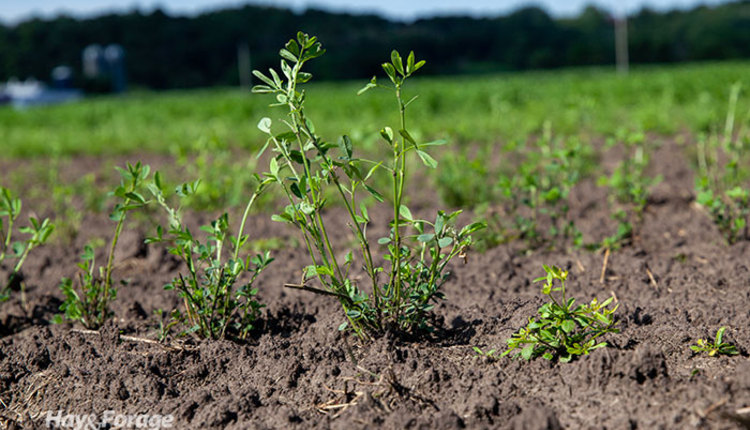
One of the core principles of plant breeding is to improve crop genetics so plants are better equipped to survive environmental stress. Genetic improvement is even more imperative when a species is grown in a climate that varies from its center of origin. Take alfalfa for example.
Alfalfa originated in the fertile crescent of western Asia around 10,000 B.C., growing in the desert regions of modern-day countries like Turkey, Syria, and Egypt. Because of its value as livestock feed, it was transported into central Asia, northern Africa, and China before it entered parts of Europe, likely by the Roman army.
It wasn’t until the 16th century that alfalfa arrived in Mexico, beginning its expansion into South America and what is now California and the southwestern United States. Alfalfa was initially introduced to modern-day Georgia, South Carolina, and Virginia.
At the National Alfalfa & Forage Alliance’s (NAFA) Alfalfa Intensive Training Seminar held earlier this month in Arden Hills, Minn., Craig Sheaffer with the University of Minnesota explained that the migration of alfalfa encouraged intermingling of plant genetics. Despite the natural adaptations that occurred over time, the agronomist emphasized the early efforts of two plant breeding pioneers whose work laid the foundation for the alfalfa varieties we have today.
It began with Grimm
Wendelin Grimm immigrated to Minnesota from Germany in 1857, bringing 20 pounds of alfalfa seed along with him. The seed was not a uniform variety, but rather a mixed population of purple- and yellow-flowered alfalfa that he planted on his farm in Carver County. Grimm later harvested seed from the plants that outlasted the harsh Minnesota winter.
Grimm continued to plant seed and select forage for the next several years, which eventually led him to develop the first North American winterhardy variety of alfalfa. By 1930, his alfalfa extended out of Minnesota into North Dakota, South Dakota, and eastern Montana, and alfalfa acreage in this northern tier of the United States soared from 700 acres to about 700,000. That said, the forage was lacking a key characteristic.
“Gimm’s alfalfa had tremendous winterhardiness, and it was well-adapted to certain parts of the state, but it had no disease resistance,” Sheaffer said.
Enter N.E. Hansen, a plant explorer from South Dakota. According to Sheaffer, Hansen made eight trips across the Atlantic Ocean to gather exotic varieties of winterhardy alfalfa in parts of Europe and Asia, including Turkestan alfalfa, which exhibited resistance to bacterial wilt. Other traits derived from Hansen’s material were drought tolerance, insect resistance, branched crowns, and creeping roots. Some yellow-flowered alfalfa varieties that are now grown in drier regions were also derived from Hansen’s material.
New alfalfa varieties continued to be developed throughout the 1900s — including those with resistance to stem nematode, phytophthora root rot, and anthracnose — before Roundup Ready alfalfa and reduced lignin varieties were released in the early 2000s.
Sheaffer noted that once alfalfa was recognized as a profitable crop, research moved from public institutions to private entities. Breeding objectives also shifted from promoting plant protection and disease resistance to bolstering better yields and persistence. This led to widespread planting, which prompted mechanical innovations and organizational advancements that have contributed to the evolution of the alfalfa industry as well.
More modifications to come
Today, alfalfa alternates as the third- or fourth-most valuable crop in the United States, following corn, soybeans, and sometimes wheat. Data from NAFA pegged the alfalfa industry to be worth $11.6 billion in 2021, and it was the number one field crop for many Western states, including Oregon, Idaho, Nevada, Utah, Arizona, and New Mexico. Despite this, acres of alfalfa harvested for hay and haylage have shown a slight yet steady decline over the past few decades.
Sheaffer suggested the drop in alfalfa acreage could be a result of a smaller national dairy herd, or that there is less alfalfa being included in dairy rations overall. A more prominent reason may be that federal funding for alfalfa research pales in comparison to that of corn and soybeans, as well as less economically valuable field crops like cotton and rice.
But the benefits of alfalfa go beyond its economic contribution. Ecosystem services like carbon sequestration, nitrogen fixation, and soil stabilization make growing alfalfa much more sustainable than growing corn and soybeans. Other services like wildlife habitat and nutrient retention add to alfalfa’s accolades, but overlooking these attributes exacerbates its underappreciation.
“Alfalfa is at another level,” Sheaffer asserted. “It can do all of these things, but the crop’s monetary value is undervalued.”
In order for the queen of forages to be treated like a commodity, Sheaffer said there must be a push for more research funding in the future. There is potential to improve existing resistant varieties and discover new ways to prevent pests and diseases if the industry has sufficient support.
Introducing tannins into alfalfa could enhance protein bypass in the rumen, which would allow more of the nutrient to be available to cattle. Furthermore, tannins reduce frothy bloat caused by legumes, which may offer greater opportunities for grazing livestock on alfalfa. Scientists with the USDA Agricultural Research Service in St. Paul, Minn., have also been evaluating alfalfa germplasm for hyper-accumulation of phosphorus in the soil. This could enhance alfalfa’s ability to grow in soils with low phosphorus levels, as well as remediate soils with excess phosphorus.
Reinvigorating alfalfa research may require exploring new markets, such as growing alfalfa for commercial enzyme production, utilizing plants stems for renewable energy, or using the forage for fish food. Sheaffer also pointed to the possibility of growing alfalfa for human consumption by substituting alfalfa protein for pea or soy protein in plant-based foods.
While these options exist, the primary focus of government funding will likely remain on refining alfalfa genetics to enhance forage yield, quality, and persistence while emphasizing its multitude of environmental benefits. With that said, looking back on how far alfalfa has already come may inspire plant breeding and advocacy efforts moving forward.

